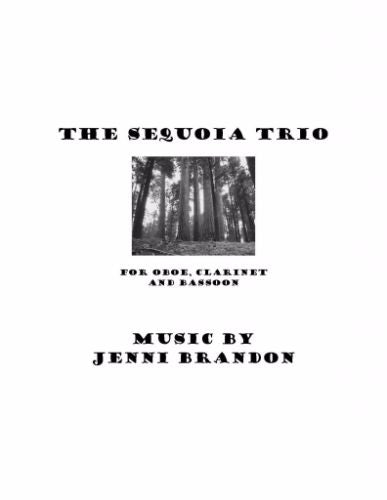The Sequoia Trio (score & parts) - OB/CL/BSN
Composer: Brandon, Jenni
Publisher: Jenni Brandon
Edition: 62240
$28.00
for oboe, clarinet, and bassoon
by Jenni Brandon (b. 1977) - American composer
A beautifully crafted and edited 4 movement work depicting the great sequoia trees of the American west. A great program piece that is enjoyable for performers and audience.
The Sequoia Trio was written for Vientos Trio of Los Angeles, for whom Brandon was the composer-in-residence During 2008-2009. Brandon had recently returned from a trip to Sequoia National Park in July of 2008 and was inspired by the great trees. This proved to be the basis for the new work, and in searching for a voice, the composer turned to the words of John Muir for inspiration.
Each movement takes a quote about these trees from John Muir’s book, The Yosemite, and uses it to inspire the music. In movement one, Brandon was struck by “graceful compliance” in that, although the trees are massive, there is still something gentle and approachable in their fluid motions. The opening waving pattern creates the gentle breeze as the growth of the trees starts in the bassoon, moving through the clarinet and all the way to the top of the trees with oboe. “A crowd of hopeful young saplings…” is sassy and jazzy, giving the young trees the kind of resilient attitude that they must maintain in order to survive. “The Three Graces” plays on the idea of the three instruments in the ensemble and Muir’s own reference to Greek mythology, or the goddesses of charm, beauty, and creativity. The trees might stand next to each other, yet separately, for years, but eventually their trunks will touch and meld together. Each instrument takes its turn becoming part of this conglomeration by leaving the tutti staccato patterns with a held note and then launching into the melody while the other two continue the staccato pattern of growth. Finally in “The Noble Trees” the instruments play a hymn-like tribute to the largest living things on earth, ending with remembrance of the opening movement and their graceful waving branches. Following movements one and three are two “Tree Interludes”. These represent the individual voice of a tree, allowing it to speak out across the forest and tell us its story and the history it has seen for thousands of years.
Duration: 14:40


Share this item: